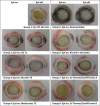A study of stromal riboflavin absorption in ex vivo porcine corneas using new and existing delivery protocols for corneal cross-linking
- PMID: 26421680
- PMCID: PMC4973833
- DOI: 10.1111/aos.12884
A study of stromal riboflavin absorption in ex vivo porcine corneas using new and existing delivery protocols for corneal cross-linking
Abstract
Purpose: To indirectly measure stromal riboflavin penetration using commercially available riboflavin solutions and new and existing epithelium-off, trans-epithelial and iontophoresis-assisted delivery protocols.
Methods: Forty porcine eyes were divided into eight groups. Group 1: Ricrolin applied to the de-epithelialised cornea for 30 min; Group 2: epithelium-intact, no treatment; Groups 3-5: epithelium-intact, 30-min application of Ricrolin TE, Mediocross TE or ParaCel/Vibex, respectively. Group 6: epithelium-intact, Ricrolin(+) iontophoresis-assisted delivery for 5 min; Group 7: epithelium-intact, Ricrolin(+) iontophoresis-assisted delivery for 5 min with a 20-min riboflavin soak; and Group 8: epithelium-intact, Ricrolin(+) iontophoresis-assisted delivery for 5 min, 15-min soak and another 5 min of iontophoresis. After a saline wash, light transmission spectra were obtained from each cornea, before and after epithelial removal.
Results: Corneas in groups 1 and 8 showed a distinct riboflavin absorption peak between 400 and 520 nm. The optical density of the corneas in groups 3-7 did not differ significantly from that of the untreated corneas (group 2).
Conclusions: A modification to the standard iontophoresis trans-epithelial technique resulted in successful penetration of riboflavin into the stroma and appears to offer the most promise for epithelium-on cross-linking.
Keywords: cornea; cross-linking; iontophoresis; spectrophotometry.
© 2015 The Authors. Acta Ophthalmologica published by John Wiley & Sons Ltd on behalf of Acta Ophthalmologica Scandinavica Foundation and European Association for Vision & Eye Research.
Figures






Similar articles
-
Transepithelial Riboflavin Absorption in an Ex Vivo Rabbit Corneal Model.Invest Ophthalmol Vis Sci. 2015 Jul;56(8):5006-11. doi: 10.1167/iovs.15-16903. Invest Ophthalmol Vis Sci. 2015. PMID: 26230765
-
Effect of epithelial retention and removal on riboflavin absorption in porcine corneas.J Refract Surg. 2009 Sep;25(9):771-5. doi: 10.3928/1081597X-20090813-03. Epub 2009 Sep 11. J Refract Surg. 2009. PMID: 19772262
-
Evaluation of transepithelial stromal riboflavin absorption with enhanced riboflavin solution using spectrophotometry.J Cataract Refract Surg. 2012 May;38(5):884-9. doi: 10.1016/j.jcrs.2011.11.049. J Cataract Refract Surg. 2012. PMID: 22520311
-
Transepithelial versus epithelium-off corneal crosslinking for progressive keratoconus.Cochrane Database Syst Rev. 2021 Mar 23;3(3):CD013512. doi: 10.1002/14651858.CD013512.pub2. Cochrane Database Syst Rev. 2021. PMID: 33765359 Free PMC article.
-
Corneal cross-linking.Prog Retin Eye Res. 2025 Jan;104:101322. doi: 10.1016/j.preteyeres.2024.101322. Epub 2024 Dec 15. Prog Retin Eye Res. 2025. PMID: 39681212 Review.
Cited by
-
Transepithelial corneal cross-linking assisted by two continuous cycles of iontophoresis for progressive keratoconus in adults: retrospective 5-year analysis.Graefes Arch Clin Exp Ophthalmol. 2021 Jan;259(1):239-246. doi: 10.1007/s00417-020-04861-y. Epub 2020 Jul 29. Graefes Arch Clin Exp Ophthalmol. 2021. PMID: 32725404 Free PMC article.
-
Standard and accelerated crosslinking protocols in keratoconus - differences and evolution at one year.Rom J Ophthalmol. 2025 Apr-Jun;69(2):175-183. doi: 10.22336/rjo.2025.29. Rom J Ophthalmol. 2025. PMID: 40698114 Free PMC article.
-
An investigation into corneal enzymatic resistance following epithelium-off and epithelium-on corneal cross-linking protocols.Exp Eye Res. 2016 Dec;153:141-151. doi: 10.1016/j.exer.2016.10.014. Epub 2016 Oct 17. Exp Eye Res. 2016. PMID: 27765574 Free PMC article.
-
Enhanced Transepithelial Riboflavin Delivery Using Femtosecond Laser-Machined Epithelial Microchannels.Transl Vis Sci Technol. 2020 May 11;9(6):1. doi: 10.1167/tvst.9.6.1. eCollection 2020 May. Transl Vis Sci Technol. 2020. PMID: 32821498 Free PMC article.
-
Clinical and microstructural changes with different iontophoresis-assisted corneal cross-linking methods for keratoconus.Int J Ophthalmol. 2019 Feb 18;12(2):219-225. doi: 10.18240/ijo.2019.02.06. eCollection 2019. Int J Ophthalmol. 2019. PMID: 30809476 Free PMC article.
References
-
- Bouheraoua N, Jouve L, El Sanharawi M et al. (2014): Optical coherence tomography and confocal microscopy following three different protocols of corneal collagen‐crosslinking in keratoconus. Invest Ophthalmol Vis Sci 55: 7601–7609. - PubMed
-
- Caporossi A, Mazzotta C, Baiocchi S, Caporossi T & Paradiso A (2012): Transepithelial corneal collagen crosslinking for keratoconus: qualitative investigation by in vivo HRT II confocal analysis. Eur J Ophthalmol 22: S81–S88. - PubMed
-
- Elsheikh A, Wang D, Brown M, Rama P, Campanelli M & Pye D (2007): Assessment of corneal biomechanical properties and their variation with age. Curr Eye Res 32: 11–19. - PubMed
-
- Filippello M, Stagni E & O'Brart D (2012): Transepithelial corneal collagen crosslinking: bilateral study. J Cataract Refract Surg 38: 283–291. - PubMed
-
- Ghanem V, Ghanem R & de Oliveira R (2013): Postoperative pain after corneal collagen cross‐linking. Cornea 32: 20–24. - PubMed
Publication types
MeSH terms
Substances
Grants and funding
LinkOut - more resources
Full Text Sources
Other Literature Sources

